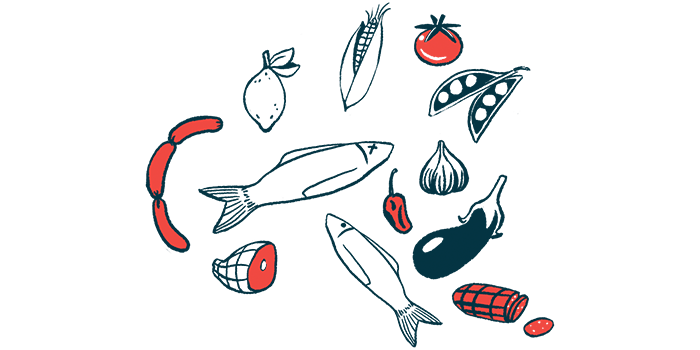Poor nutrition linked to worse quality of life in NMOSD: Study
Sleep quality, disease duration, depression associated with nutritional status

Neuromyelitis optica spectrum disorder (NMOSD) patients have significantly poorer nutritional status than healthy people which is associated with worse quality of life, a study found.
Longer disease duration; poor sleep quality; being a woman; and higher levels of anxiety, depression, or fatigue were found to be significantly associated with poor nutrition in people with NMOSD.
This suggests “a multifaceted and personalized intervention is required to improve the prognosis of NMOSD,” the researchers wrote.
The study, “The nutritional risk in patients with neuromyelitis optica spectrum disorder,” was published in the journal Multiple Sclerosis and Related Disorders.
NMOSD is a rare autoimmune disease in which the immune system goes awry and causes damaging inflammation mainly to the eye nerves (optic neuritis) and the spinal cord (transverse myelitis).
While people with NMOSD are not usually recommended any special diet, “the influence of nutrition on the inflammatory pathways that mediate autoimmune diseases is well known,” the researchers wrote.
Previous studies have suggested that “dietary habits with high inflammatory potential were related to an increased risk of NMOSD,” the researchers wrote, while diets with antioxidant effects were associated with a lower risk of NMOSD.
However, the nutritional status of people with NMOSD remains unknown.
“It is necessary to pay attention to the nutritional status of NMOSD patients,” the researchers wrote, adding that “early assessment may promote early intervention and further help to improve the prognosis of NMOSD patients.”
Evaluating the nutritional status of 70 patients, 66 healthy people
With this in mind, a team of researchers in China evaluated the nutritional status of 70 NMOSD patients and 66 healthy people and investigated potential links with quality of life in the patient group.
Mean age was about the same in the two groups (41.4 vs. 40 years), as was the proportion of women (80% vs. 72.7%).
About 4 in 10 NMOSD patients (42.9%) had both optic neuritis and transverse myelitis, more than one-third (35.7%) had transverse myelitis alone, and 22.9% only optic neuritis.
Four patients (5.7%) also had area postrema syndrome, a condition characterized by uncontrollable nausea, vomiting, and/or hiccups that can occur early in the course of NMOSD.
Nutritional status was assessed with the Mini Nutritional Assessment (MNA), a tool that can identify people who have or are at risk of malnutrition, or poor nutrition, in which there is an imbalance between the nutrients your body needs to function and those it gets.
MNA covers four dimensions: body measurements, general status, eating habits, and self-perceived health and nutritional status. Its score ranges from 0 to 30, with 24 points or more indicating good nutrition, 17-23.5 points reflecting risk of malnutrition, and less than 17 points indicating malnutrition.
Significant difference in MNA scores between people with NMOSD, health controls
People with NMOSD had significantly lower MNA scores than healthy controls (20.4 vs. 23.3 points). This difference was driven by significantly lower scores in the general status and self-perceived health and nutritional status domains in the NMOSD group.
Nearly three-quarters of patients (74.3%) were at risk of malnutrition, and eight (11.4%) already showed poor nutrition, highlighting that “the risk of malnutrition in NMOSD patients was high,” the team wrote.
To find out how nutrition affected NMOSD patients’ quality of life, the researchers used the 36-Item Short Form Survey (SF-36), a measure of eight dimensions of quality of life. Its total score ranges from 0 to 145, with lower scores indicating worse life quality.
They found lower MNA scores were significantly associated with lower SF-36 scores in seven of the eight dimensions: physical functioning, bodily pain, general health, vitality, social functioning, emotional roles, and mental health. This meant that poor nutrition was linked to worse quality of life.
The researchers then looked for factors associated with poor nutritional status. They found women scored significantly lower in the MNA than men, specifically in the eating habits and self-perceived health and nutritional status domains.
Moreover, worse nutritional status was significantly linked to longer disease duration, more disease attacks, worse sleep quality, and more severe anxiety, depression, and fatigue.
Further analysis revealed that poor sleep was an independent risk factor for malnutrition, and that being a woman was an independent risk factor for poor eating habits as well as worse self-perceived health and nutritional status.
While the study lacked laboratory data about nutrition, it indicates “the risk of malnutrition is very high in patients with NMOSD, with nearly 85% of these individuals being at risk of malnutrition or having definite malnutrition,” the researchers wrote.
The findings also highlighted that “nutritional status is closely related to the quality of life of NMOSD patients,” the team wrote, and that “the malnutrition of NMOSD is caused by the combination of various social, physiological, and psychological change.”
“Special attention needs to be paid to the nutritional status of female patients, patients with more attacks, or patients with longer disease duration,” the researchers wrote.
Still, larger studies, collecting more nutritional information, “are warranted to gain more knowledge regarding the nutritional status of NMOSD patients,” the team concluded.






